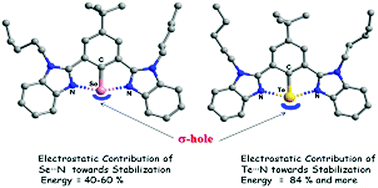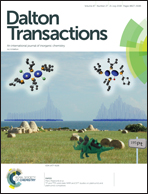Synthesis and structure of arylselenium(ii) and aryltellurium(ii) cations based on rigid 5-tert-butyl-1,3-bis-(N-pentylbenzimidazol-2′-yl)benzenes†
Abstract
The transmetalation reactions of a mercury precursor, [Pentyl(N^C^N)HgCl] (19), with selenium halides (SeCl4, SeBr4, and SeCl2) were attempted to obtain the corresponding organoselenium trichloride [Pentyl(N^C^N)SeCl3], tribromide [Pentyl(N^C^N)SeBr3], and monochloride [Pentyl(N^C^N)SeCl], respectively [(N^C^N) = 5-tert-butyl-1,3-bis-(N-pentyl-benzimidazol-2′-yl)phenyl]. However, in all the cases, a very facile ionization of the Se–halogen bond was observed leading to the isolation of a new class of air stable arylselenium(II) complexes: [Pentyl(N^C^N)Se+]2[HgCl4]2− (20) and [Pentyl(N^C^N)Se+]2[HgBr4]2− (21). This is the first report on the formation of NCN pincer-based arylselenium(II) cations via the transmetalation route. Similar reactions were further investigated with several tellurium precursors: {TeCl4, TeBr4 and TeI2} which resulted in the formation of analogous aryltellurium(II) complexes: [Pentyl(N^C^N)Te+]2[HgCl4]2− (22), [Pentyl(N^C^N)Te+][Cl]− (23), [Pentyl(N^C^N)Te+]2[HgBr4]2− (24), [Pentyl(N^C^N)Te+][Br]− (25) and [Pentyl(N^C^N)Te+]4[Hg2Cl4.72I3.28]4− (26). These are only the second set of examples of aryltellurium cations (hypervalent 10-Te-3 species) with the NCN pincer-based ligand, characterised by X-ray crystallographic studies. The crystallographic studies show a strong Se⋯N/Te⋯N intramolecular interaction, which is confirmed by NBO calculations suggesting the donation of a lone pair of electrons on nitrogen to a lone p-vacancy on selenium/tellurium atoms. The analysis based on NPA derived charges indicates that the contribution of Se⋯N interactions to the electrostatic stabilization energy is in the range of 40–60%, whereas Te⋯N interactions have a contribution of about 84% and more, attributed to the differences in the electronegativity of selenium and tellurium. Furthermore, the formation of arylselenium(II) and aryltellurium(II) complexes was favoured due to the presence of the σ-hole on the Se/Te centres.

- This article is part of the themed collection: Selenium & Tellurium chemistry at the beginning of the 3rd millennium: a celebration of ICCST


 Please wait while we load your content...
Please wait while we load your content...